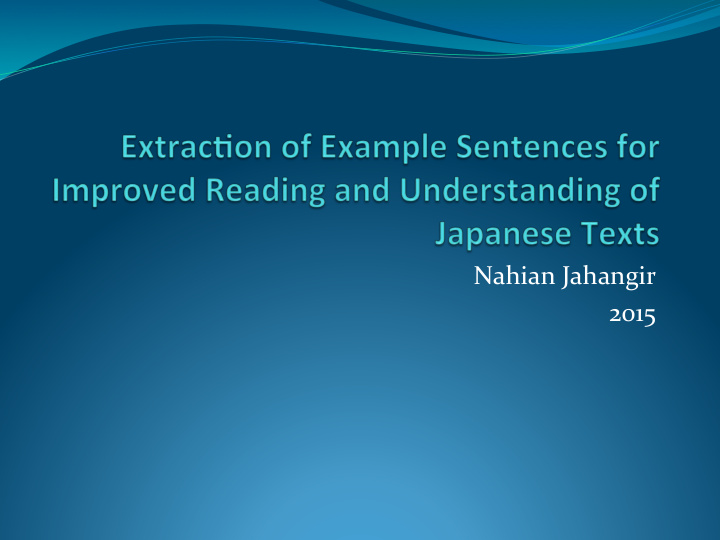



Nahian ¡Jahangir ¡ 2015 ¡ ¡
The ¡Ambiguous ¡Nature ¡of ¡ Language ¡ ¡ ¡ “Mary ¡ engaged ¡Tom ¡with ¡her ¡veritable ¡knowledge ¡of ¡ petunias ¡and ¡her ¡sleight ¡of ¡hand ¡tricks.” ¡ ¡ Definition ¡of ¡Engage: ¡ (verb) ¡to ¡occupy ¡the ¡attention ¡or ¡efforts ¡(of ¡people) ¡ (verb) ¡to ¡betroth ¡ (verb) ¡enter ¡into ¡conflict ¡with ¡ ¡ ¡
Solu6on? ¡ Example ¡Sentences ¡ For ¡example: ¡ “The ¡children ¡ engaged ¡the ¡teacher ¡by ¡asking ¡several ¡ questions ¡about ¡the ¡subject.” ¡ ¡ Advantages ¡ Simpler ¡terms ¡ Retains ¡context ¡ Uses ¡basic ¡grammar ¡
Why ¡Japanese? ¡ ¡ “ 大学の食堂でハンバーガを食べてもいいですか? ” ¡ Is ¡it ¡okay ¡if ¡we ¡eat ¡hamburgers ¡at ¡the ¡college ¡cafeteria? ¡ ¡ Difficulties ¡of ¡Japanese ¡Language ¡ Three ¡different ¡writing ¡systems: ¡hiragana ¡ ひらがな , ¡ katakana ¡ カタカナ , ¡and ¡kanji ¡ 漢字 . ¡ Heavily ¡context-‑based ¡language ¡ Level ¡4 ¡Language-‑ ¡classified ¡by ¡DLI 1 ¡ ¡ ¡ ¡ 1: ¡The ¡defense ¡language ¡institute. ¡http://new.dliflc.edu/. ¡Accessed: ¡10/05/2015. ¡ ¡
Applying ¡it ¡to ¡Japanese ¡ 両親が年をとったら面倒を見るつもりです ¡ 面倒 ! [mendou] ¡(Na-‑ ¡adjective, ¡noun)* ¡ ¡ Trouble; ¡Difficulty; ¡Care; ¡Attention ¡ Context ¡Examples ¡ 面倒を見る ! -‑ ¡to ¡care ¡for ¡someone; ¡to ¡look ¡after ¡ someone ¡ 面倒を掛ける ! -‑ ¡to ¡put ¡someone ¡to ¡trouble ¡ あなたが買物に行っている間、子供の面倒を見ま しょう ¡ ¡ *Definitions ¡courtesy ¡of ¡jisho.org, ¡an ¡online ¡electronic ¡dictionary ¡server ¡
How ¡would ¡it ¡work? ¡ Takes ¡Input ¡ Target ¡ Word ¡ Program ¡ Input ¡ Corpus ¡ Source ¡Sentence ¡ Returns ¡potential ¡ Returns ¡the ¡best ¡ Example ¡ Sentence ¡
The ¡Tanaka ¡Corpus 2 ¡ Characteristics ¡ Multi-‑lingual ¡parallel ¡corpus ¡of ¡English ¡and ¡Japanese ¡ Sentences ¡were ¡every ¡day ¡use ¡sentences ¡ Edited ¡and ¡corrected ¡for ¡mistakes ¡ Further ¡alterations ¡ Removed ¡English ¡sentences ¡and ¡duplicate, ¡formatted ¡ sentences ¡ From ¡420,000 ¡sentences ¡ à ¡ 149,298 ¡sentences ¡ 2: ¡Electronic ¡dictionary ¡research ¡and ¡development ¡group. ¡ http://www.edrdg.org/wiki/index.php. ¡Accessed: ¡21/11/2014. ¡ ¡
The ¡LESK ¡Algorithm ¡ Overview 3 ¡ Introduced ¡by ¡Michael ¡E. ¡Lesk ¡in ¡1986 ¡ Derives ¡from ¡word ¡sense ¡disambiguation ¡ Problems ¡ Need ¡exact ¡definitions ¡ Limited ¡to ¡dictionary ¡glosses ¡ ¡ Solution-‑Simplified ¡Lesk ¡Algorithm ¡ 3: ¡Agirre, ¡Eneko, ¡and ¡Philip ¡Edmonds. ¡"Word ¡Sense ¡Disambiguation: ¡Algorithms ¡and ¡ Applications." ¡
Simplified ¡LESK ¡Algorithm ¡ function ¡SIMPLIFIED ¡LESK( word,sentence ) ¡ returns ¡ best ¡sense ¡of ¡word ¡ ¡best-‑sense ¡ ß ¡most ¡frequent ¡sense ¡for ¡word ¡ ¡max-‑overlap ¡ ß ¡0 ¡ ¡context ¡ ß ¡set ¡of ¡words ¡in ¡sentence ¡ ¡for ¡each ¡ sense ¡ in ¡ senses ¡of ¡word ¡ do ¡ ¡ ¡ signature ¡ ß ¡set ¡of ¡words ¡in ¡the ¡gloss ¡and ¡examples ¡of ¡sense ¡ ¡ ¡overlap ¡ ß ¡COMPUTEOVERLAP ¡( signature,context ) ¡ ¡ ¡if ¡ overlap ¡> ¡max-‑overlap ¡ then ¡ ¡ ¡ ¡ max-‑overlap ¡ ß ¡overlap ¡ ¡ ¡ ¡best-‑sense ¡ ß ¡ sense ¡ ¡end ¡ return ¡( best-‑sense ) ¡ ¡
Baseline ¡ function ¡ OVERLAP(word, ¡sentence) ¡ returns ¡ best ¡example ¡sentence ¡ ¡best ¡score ¡ ß ¡0 ¡ ¡ ¡example ¡sentence ¡ ß ¡”” ¡ ¡ ¡source ¡vector ¡ ß ¡SETCREATION( sentence ) ¡ ¡ ¡for ¡ other ¡sentence ¡ in ¡ corpus ¡ do ¡ ¡ ¡ ¡other ¡vector ¡ ß ¡SETCREATION( other ¡sentence ) ¡ ¡ ¡ ¡ if ¡ word ¡ in ¡ other ¡vector ¡ then ¡ ¡ ¡ ¡ ¡ score ¡ ß ¡COMPARE_OVERLAP( vector , ¡ other ¡vector ) ¡ ¡ ¡ ¡ ¡ if ¡ score ¡> ¡ best ¡score ¡ then ¡ ¡ ¡ ¡ ¡ ¡ best ¡score ¡ ß ¡ score ¡ ¡ ¡ ¡ ¡ ¡ example ¡sentence ¡ ß ¡ other ¡sentence ¡ ¡ ¡end ¡return ¡ example ¡sentence ¡
Test ¡Sentences ¡ 両親 ¡ 両親が年をとったら面倒を見るつもりです ¡ Translation: ¡In ¡the ¡case ¡my ¡parents ¡get ¡older ¡with ¡age, ¡I ¡will ¡ look ¡after ¡them. ¡ 頼む ¡ 夕方になると忙しくなるから、頼むよ ¡ Translation: ¡In ¡the ¡evening ¡it ¡will ¡get ¡busy, ¡so ¡I ¡am ¡counting ¡ on ¡you. ¡ 安い ¡ バスと電車とどっちのほうが安いですか ¡ Translation: Which ¡is ¡cheaper, ¡(going ¡by) ¡bus ¡or ¡(by) ¡train? ¡
Baseline ¡Results ¡ ! (105) ¡ 両親 ! 9,13 ¡23, ¡27, ¡44, ¡58, ¡60, ¡71, ¡73, ¡ ¡ ! (27) ¡ 頼む ! 11, ¡13 ¡,23 ¡ 安い ¡(80) ¡ 15, ¡17, ¡29, ¡38, ¡43, ¡63, ¡64, ¡67, ¡68, ¡74, ¡79 ¡ ¡ ¡ ¡
Evalua6ons ¡ Longer ¡sentences ¡hold ¡unfair ¡advantage ¡ Normalization ¡solves ¡for ¡this ¡ Improvements/Approaches ¡ Remove ¡stop ¡words ¡(particles) ¡ Collocation ¡of ¡Sentences ¡(Method ¡#1) ¡
Method ¡#1 ¡Results ¡ ! (105) ¡ 両親 ! 3, ¡10, ¡25, ¡28, ¡34, ¡38, ¡45, ¡52, ¡93 ¡ ! (27) ¡ 頼む ! 14, ¡16, ¡27 ¡ 安い ¡(80) ¡ 7, ¡16, ¡21, ¡23, ¡37, ¡40, ¡44, ¡47, ¡56, ¡64, ¡68 ¡ ¡
Evalua6ons ¡ Overall ¡scores ¡were ¡generally ¡higher ¡ Collocations ¡based ¡on ¡common ¡phrases ¡found ¡ throughout ¡corpus ¡ à ¡higher ¡scores ¡given ¡to ¡them ¡ Improvements/Approaches ¡ Weighting ¡the ¡words ¡(Method ¡#2) ¡ ¡
Method ¡#2 ¡ ! (105) ¡ 両親 ! 8, ¡10, ¡11, ¡35, ¡43, ¡65, ¡81, ¡84, ¡85, ¡86, ¡ ¡ ! (27) ¡ 頼む ! 17, ¡22, ¡25 ¡ 安い ¡(80) ¡ 17, ¡27, ¡29, ¡30, ¡34, ¡40, ¡54, ¡59, ¡65, ¡66, ¡69 ¡
Evalua6ons/Discussion ¡ Longer ¡sentences ¡had ¡more ¡opportunities ¡to ¡score ¡ higher ¡ Try ¡normalizing ¡ Future ¡Work ¡ Normalization ¡and ¡stop ¡character ¡removal ¡ ¡ Incorporate ¡Kanji ¡Proficiency ¡ ¡ Continuing ¡Method ¡1 ¡ Including ¡more ¡corpora ¡
Recommend
More recommend